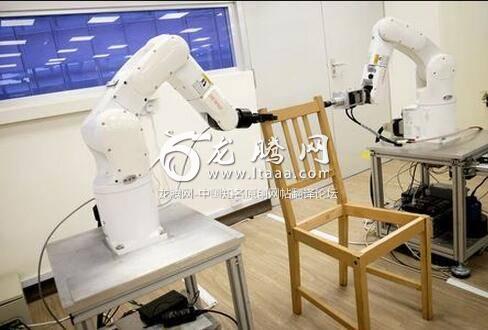机器人完成了人类“最艰难的任务”:组装宜家家具 [美国媒体]
机器人抢走了我们的工作,学会了做家务,还在比赛中打败了我们。现在,新加坡的研究人员们表示,他们已经成功地训练出机器人执行另一个备感惊讶的人类所熟知的任务:想办法组装宜家家具。
Robot Conquers One of the Hardest Human Tasks: Assembling Ikea Furniture
机器人完成了人类“最艰难的任务”:组装宜家家具
Robots have taken our jobs, learned our chores and beaten us at our own games.
机器人抢走了我们的工作,学会了做家务,还在比赛中打败了我们。
Now researchers in Singapore say they have trained one to perform another task known to confound humans: figuring out how to assemble furniture from Ikea.
现在,新加坡的研究人员们表示,他们已经成功地训练出机器人执行另一个备感惊讶的人类所熟知的任务:想办法组装宜家家具。
A team from Nanyang Technological University programmed a robot to create and execute a plan to piece together most of Ikea’s $25 solid-pine Stefan chair on its own, calling on a medley of human skills to do so. The researchers explained their work in a study published on Wednesday in the journal Science Robotics.
南洋理工大学(Nanyang Technological University)的一个团队给一个机器人编了程序,让其创造并执行计划,自主组装宜家售价25美元的松木斯第芬(Stefan)椅的大部分,要做到这一点需要各种人类的技能。研究人员周三发表在《科学机器人》(Science Robotics)杂志上的研究报告对他们的研究进行了说明。
“If you think about it, it requires perception, it requires you to plan a motion, it requires control between the robot and the environment, it requires transporting an object with two arms simultaneously,” said Dr. Quang-Cuong Pham, an assistant professor of engineering at the university and one of the paper’s authors. “Because this task requires so many interesting skills for robots, we felt that it could be a good project to push our capabilities to the limit.”
“想一想,这需要洞察力,需要你对行动做出规划,需要在机器人和环境间的控制,需要同时用两个机械臂运送一件物品,”范光强(Quang-Cuong Pham,音)博士说,他是该校的工程学助理教授,也是该论文的作者之一。“因为这项任务对机器人来说需要大量有意思的技能,我们觉得这会是一个将我们的能力拓展到极致的好项目。”
He and his Nanyang colleagues who worked on the study, Francisco Suárez-Ruiz and Xian Zhou, aren’t alone.
他和南洋理工大学一道进行这项研究的同事弗朗西斯科·苏亚雷斯-鲁伊斯(Francisco Suárez-Ruiz)及周宪(音)并非独行者。
In recent years, a handful of others have set out to teach robots to assemble Ikea furniture, a task that can mimic the manipulations robots can or may someday perform on factory floors and that involves a brand many know all too well.
近年来,其他一些人也开始教机器人组装宜家家具,这个任务可以模拟机器人有朝一日能够或者可能在工厂里进行的操作,而且它涉及一个许多人熟知的品牌。
“It’s something that almost everybody is familiar with and almost everybody hates doing,” said Ross A. Knepper, an assistant professor of computer science at Cornell University, whose research focuses on human-robot interaction.
“这是几乎每个人都熟悉,也是每个人都讨厌做的事情,”康奈尔大学(Cornell University)计算机科学助理教授罗斯·A·克内珀(Ross A. Knepper)说,他的研究主要聚焦在人机交互方面。
In 2013, Mr. Knepper was part of a team at the Massachusetts Institute of Technology that presented a paper on its work in the area, describing the “IkeaBot” the team created, which could assemble the company’s Lack table on its own.
2013年的时候,克内珀曾是麻省理工大学(Massachusetts Institute of Technology)一个研究团队的成员,该团队发表了一篇相关领域的论文,对他们创造的“宜家机器人”(IkeaBot)进行了描述,这个机器人可以自主组装宜家的拉科(Lack)桌。
But chairs, with backs, stretchers and other parts, pose a more complex challenge; hence the interest of the Nanyang researchers.
但组装带有靠背、横档及其他部件的椅子难度更大,因此这激起了南洋理工大学研究人员的兴趣。
Their robot was made of custom software, a three-dimensional camera, two robotic arms, grippers and force detectors. The team chose only off-the-shelf tools, in order to mirror human biology.
他们的机器人由特别设计的软件、一个立体照相机、两只机械臂、抓握器及力感应器组成。为了模仿人类生物学,该团队选择的都是已有的现成工具。
“Humans have the same hardware to do many different things,” Dr. Pham said. “So this is kind of the genericity that we wanted to mimic.”
“人类有同样的硬件来做许多不同的事情,”范光强说。“所以这就是我们想模仿的泛型。”
Also like humans, the robot had a little help to start: It was fed a kind of manual, a set of ordered instructions on how the pieces fit together. After that, though, it was on its own.
同样地,像人类一样,这款机器人在开始组装家具时也没得到什么帮助:提供给它的是某种指南,一系列关于如何将各个部位组装起来的指令。在那之后,它就只能靠自己了。
The robot proceeded in three broad phases, spread out over 20 minutes 19 seconds.
机器人分三个大阶段开始进行,共耗时20分钟19秒。
First, like humans, it took some time to stare at the pieces scattered before it.
首先,像人类一样,它花了些时间盯着散落在自己面前的各个部位。
The robot spent a few seconds photographing the scene and matching each part to the one modeled in its “manual.”
机器人花了几秒,对眼前的景象进行拍照,把每个部位与“指南”里的进行匹配。
Then, over more than 11 minutes, the robot devised a plan that would allow it to quickly assemble the chair without its arms knocking into each other or into the various parts.
然后,在11分钟多的时间里,机器人设计了一个方案,能够让它在机械臂不相互碰撞或撞到不同零件的情况下,快速将椅子组装起来。
Finally, it put the plan in motion over the course of nearly nine minutes. The robot used grippers to pick up the wooden pins from a tray and force sensors at its “wrists” to detect when the pins, searching in a spiral pattern, finally slid into their holes. Working in unison, the arms then pressed the sides of the chair frame together.
最终,它在近9分钟时间里执行了这个方案。机器人利用抓握器从一个托盘里拿起木钉,位于其“腰部”的力感应器会以螺旋方式进行搜索,检测木钉何时应当被置入孔中。两条机械臂协同合作,然后将椅子的框架向内按压,合在一起。
Of course, the robot didn’t succeed right away. There were several failed attempts along the way and researchers tweaked the system before the robot was finally able to assemble the chair on its own.
当然,机器人也不是立刻就取得了成功。期间也有不少失败,在机器人最终能够自主组装椅子前,研究人员对系统进行了不少改动。
The accomplishment was the culmination of three years of work, but the team is eager to see what else it can automate, Dr. Pham said.
这一成就是三年努力的结果,但范光强说,该团队还渴望看到这个机器人能自动操作其他什么东西。
With the help of experts in artificial intelligence, the researchers may be able to create a robot that can build a chair by following spoken directions or by watching someone else do it first, he said. Or maybe, he said, they’ll eventually develop one that assembles furniture in a way that is truly human: by ignoring the manual altogether.
他说,在人工智能专家的帮助下,研究人员们可能会创造出一款机器人,它会听从语音指令,或先观看别人组装,再自己来动手。又或者,他说,他们最终能开发出一款能真正以人类的方式组装家具的机器人:完全忽视组装指南。
版权声明
我们致力于传递世界各地老百姓最真实、最直接、最详尽的对中国的看法
【版权与免责声明】如发现内容存在版权问题,烦请提供相关信息发邮件,
我们将及时沟通与处理。本站内容除非来源注明五毛网,否则均为网友转载,涉及言论、版权与本站无关。
本文仅代表作者观点,不代表本站立场。
本文来自网络,如有侵权及时联系本网站。
图文文章RECOMMEND
热门文章HOT NEWS
-
1
Why do most people who have a positive view of China have been to ...
- 2
- 3
- 4
- 5
- 6
- 7
- 8
- 9
- 10
推荐文章HOT NEWS
-
1
Why do most people who have a positive view of China have been to ...
- 2
- 3
- 4
- 5
- 6
- 7
- 8
- 9
- 10











